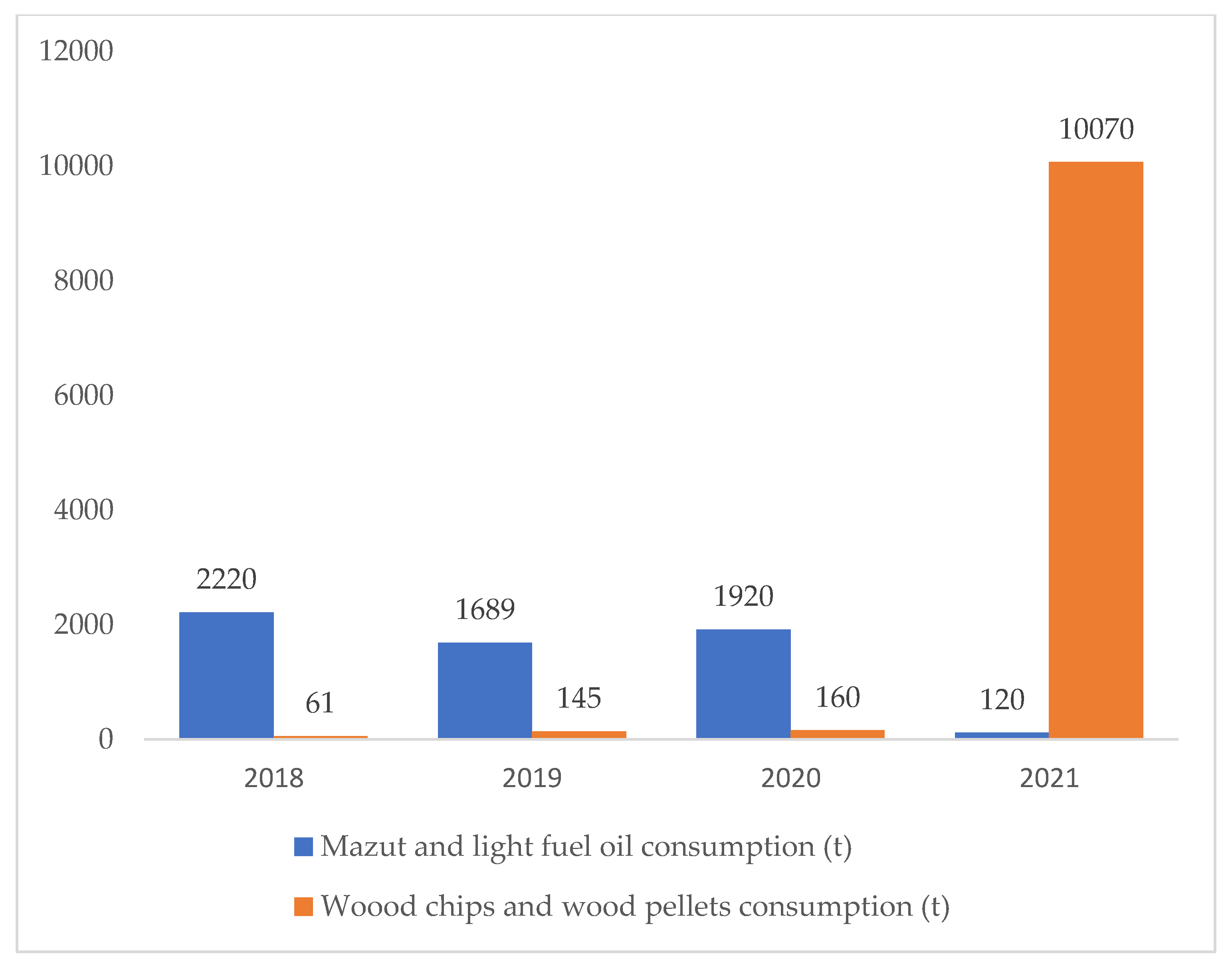Forging Local Energy Transition in the Most Carbon-Intensive European Region of the Western Balkans
Abstract
1. Introduction
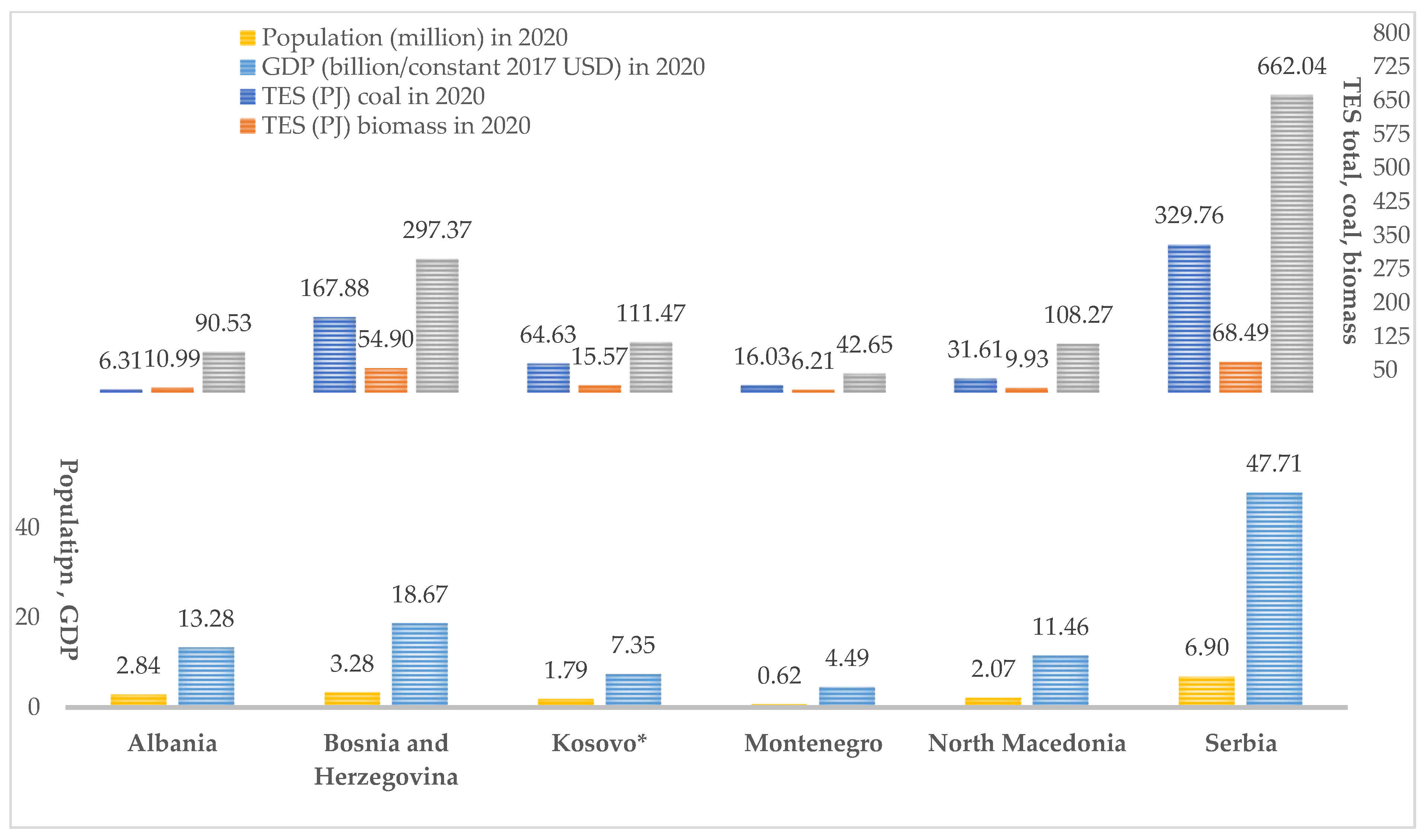
2. Research Design
2.1. Operational Framework
2.2. Within-Case Analysis and Data
3. Research Findings and Discussion
3.1. Is There Energy Transition in the WB Region?
3.2. Inconsistent Path Dependent Energy Transition in Serbia
3.3. Key Stages of the Case Development
3.3.1. The Years 2009–2015: The Window of Opportunity in the Landscape and Regime Strengthen Path-Breaking Strategic Intentions
- The poor socio-economic situation that resulted in low collection rates in the oil-based district heating system in the municipality, even though the prices were lowest in Serbia among the systems that used the same fuel.
- The need to overhaul the heat production facilities and distribution system that were old and outdated.
- The high level of CO2 and SO2 emissions and air pollution generated by the local heating system [134].
3.3.2. The Years 2016–2020: Local Actors Launched and Promoted New Niches and Governed the Regime Change
3.3.3. The Years 2021–2022: Local Renewable Heating Regime Broke the Path, Stimulating Other Innovative Local Policy Initiatives
4. Conclusions
Supplementary Materials
Author Contributions
Funding
Data Availability Statement
Conflicts of Interest
References
- Bayulgen, O. Localizing the energy transition: Town-level political and socio-economic drivers of clean energy in the United States. Energy Res. Soc. Sci. 2020, 62, 101376. [Google Scholar] [CrossRef]
- Köhler, J.; Dütschke, E.; Wittmayer, J. Introduction to “Zooming in and out: Special issue on local transition governance”. Environ. Innov. Soc. Transit. 2021, 40, 203–206. [Google Scholar] [CrossRef]
- Smedby, N.; Quitzau, M.-B. Municipal Governance and Sustainability: The Role of Local Governments in Promoting Transitions. Environ. Policy Gov. 2016, 26, 323–336. [Google Scholar] [CrossRef]
- Wittmayer, J.M.; Avelino, F.; van Steenbergen, F.; Loorbach, D. Actor roles in transition: Insights from sociological perspectives. Environ. Innov. Soc. Transit. 2017, 24, 45–56. [Google Scholar] [CrossRef]
- Bhattarai, U.; Maraseni, T.; Apan, A. Assay of renewable energy transition: A systematic literature review. Sci. Total. Environ. 2022, 833, 155159. [Google Scholar] [CrossRef]
- Bulkeley, H.; Broto, V.C.; Hodson, M.; Marvin, S. Cities and Low Carbon Transitions; Routledge: London, UK, 2010. [Google Scholar] [CrossRef]
- Capellán-Pérez, I.; Johanisova, N.; Young, J.; Kunze, C. Is community energy really non-existent in post-socialist Europe? Examining recent trends in 16 countries. Energy Res. Soc. Sci. 2020, 61, 101348. [Google Scholar] [CrossRef]
- Young, J. A Light at the End of a Tunnel or a Freight Train? A Comparative Analysis of Energy Transition in Croatia and Serbia. In From Economic to Energy Transition: Three Decades of Transitions in Central and Eastern Europe; Mišík, M., Oravcová, V., Eds.; Springer: Cham, Switzerland, 2021; pp. 545–577. [Google Scholar] [CrossRef]
- Young, J.; Brans, M. Fostering a local energy transition in a post-socialist policy setting. Environ. Innov. Soc. Transit. 2020, 36, 221–235. [Google Scholar] [CrossRef]
- Dütschke, E.; Wesche, J.P. The energy transformation as a disruptive development at community level. Energy Res. Soc. Sci. 2018, 37, 251–254. [Google Scholar] [CrossRef]
- Eliadis, P.; Hill, M.M.; Howlett, M.P. Designing Governemt: From Instruments to Governance; Eliadis, P., Hill, M., Howlett, M., Eds.; McGill Queen’s Univeristy Press: Montreal, Canada, 2005. [Google Scholar]
- Hamman, P. Local governance of energy transition: Sustainability, transactions and social ties. A case study in Northeast France. Int. J. Sustain. Dev. World Ecol. 2019, 26, 1–10. [Google Scholar] [CrossRef]
- Turcu, C.; Rydin, Y.; Pilkey, B. Energy in the locality: A case for local understanding and action. Local Environ. 2014, 19, 469–478. [Google Scholar] [CrossRef]
- Dzikuć, M.; Gorączkowska, J.; Piwowar, A.; Dzikuć, M.; Smoleński, R.; Kułyk, P. The analysis of the innovative potential of the energy sector and low-carbon development: A case study for Poland. Energy Strat. Rev. 2021, 38, 100769. [Google Scholar] [CrossRef]
- Wurzel, R.; Zito, A.; Jordan, A. Environmental governance in Europe: A comparative analysis of new environmental policy instruments. J. Environ. Law 2014, 26, 170–172. [Google Scholar] [CrossRef]
- Young, J.; Brans, M. Analysis of factors affecting a shift in a local energy system towards 100% renewable energy community. J. Clean. Prod. 2017, 169, 117–124. [Google Scholar] [CrossRef]
- REScoop.eu Network. Map. Available online: https://www.rescoop.eu/network/map?id=145006 (accessed on 12 January 2023).
- Loorbach, D.; Wittmayer, J.M.; Shiroyama, H.; Fujino, J.; Mizuguchi, S. Theory and Practice of Urban Sustainability Transitions Governance of Urban Sustainability Transitions. 2016. Available online: http://www.springer.com/series/13408 (accessed on 21 June 2022).
- Nevens, F.; Frantzeskaki, N.; Gorissen, L.; Loorbach, D. Urban Transition Labs: Co-creating transformative action for sustainable cities. J. Clean. Prod. 2013, 50, 111–122. [Google Scholar] [CrossRef]
- Đurašković, J.; Konatar, M.; Radović, M. Renewable energy in the Western Balkans: Policies, developments and perspectives. Energy Rep. 2021, 7, 481–490. [Google Scholar] [CrossRef]
- World Meteorological Organization. State of the Global Climate 2020 (Issue 1264); World Meteorological Organization: Geneva, Switzerland, 2021. [Google Scholar]
- European Commission. REPowerEU Plan {SWD(2022) 230 Final. Communication from the Commission to the European Parliament, the European Council, the Council, the European Economic and Social Committee and the Committee of the Regions. Brussels, 18.5.2022 COM(2022) 230 Final. Available online: https://eur-lex.europa.eu/resource.html?uri=cellar:fc930f14-d7ae-11ec-a95f-01aa75ed71a1.0001.02/DOC_1&format=PDF (accessed on 26 May 2022).
- Dragović, N.M.; Vuković, M.D.; Riznić, D.T. Potentials and prospects for implementation of renewable energy sources in Serbia. Therm. Sci. 2019, 23, 2895–2907. [Google Scholar] [CrossRef]
- Golusin, M.; Tesic, Z.; Ostojic, A. The analysis of the renewable energy production sector in Serbia. Renew. Sustain. Energy Rev. 2010, 14, 1477–1483. [Google Scholar] [CrossRef]
- Hakala, E.; Bjelic, I.B. Leapfrogging potential for sustainable energy transition in Serbia. Int. J. Energy Sect. Manag. 2016, 10, 381–401. [Google Scholar] [CrossRef]
- Karakosta, C.; Flouri, M.; Dimopoulou, S.; Psarras, J. Analysis of renewable energy progress in the western Balkan countries: Bosnia–Herzegovina and Serbia. Renew. Sustain. Energy Rev. 2012, 16, 5166–5175. [Google Scholar] [CrossRef]
- Pavlović, T.; Milosavljević, D.; Radonjić, I.; Pantić, L.; Radivojević, A.; Pavlović, M. Possibility of electricity generation using PV solar plants in Serbia. Renew. Sustain. Energy Rev. 2013, 20, 201–218. [Google Scholar] [CrossRef]
- Tešić, M.; Kiss, F.; Zavargo, Z. Renewable energy policy in the Republic of Serbia. Renew. Sustain. Energy Rev. 2011, 15, 752–758. [Google Scholar] [CrossRef]
- Vasić, G. Application of multi criteria analysis in the design of energy policy: Space and water heating in households—City Novi Sad, Serbia. Energy Policy 2018, 113, 410–419. [Google Scholar] [CrossRef]
- IEA. International Energy Agency. Data and Statistics. Energy Statistics Data Browser. 2022. Available online: https://www.iea.org/data-and-statistics/data-tools/energy-statistics-data-browser?country=WORLD&fuel=Energy%20supply&indicator=TESbySource (accessed on 20 January 2023).
- CHELEM-GDP. Gross Domestic Product, Population and Exchange Rate Data Base. 2022. Available online: https://db.nomics.world/CEPII/CHELEM-GDP (accessed on 20 January 2023).
- Law on Territorial Organisation. Official Gazette of the Republic of Serbia, no. 129/2007, 18/2016, 47/2018 and 9/2020–Other Law. Available online: https://www.paragraf.rs/propisi/zakon_o_teritorijalnoj_organizaciji_republike_srbije.html (accessed on 19 January 2023).
- Farla, J.; Markard, J.; Raven, R.; Coenen, L. Sustainability transitions in the making: A closer look at actors, strategies and resources. Technol. Forecast. Soc. Chang. 2012, 79, 991–998. [Google Scholar] [CrossRef]
- Kern, F.; Rogge, K.S. The pace of governed energy transitions: Agency, international dynamics and the global Paris agreement accelerating decarbonisation processes? Energy Res. Soc. Sci. 2016, 22, 13–17. [Google Scholar] [CrossRef]
- Kern, F.; Smith, A.; Shaw, C.; Raven, R.; Verhees, B. From laggard to leader: Explaining offshore wind developments in the UK. Energy Policy 2014, 69, 635–646. [Google Scholar] [CrossRef]
- Lawhon, M.; Murphy, J.T. Socio-technical regimes and sustainability transitions: Insights from political ecology. Prog. Hum. Geogr. 2012, 36, 354–378. [Google Scholar] [CrossRef]
- Meadowcroft, J. What about the politics? Sustainable development, transition management, and long term energy transitions. Policy Sci. 2009, 42, 323–340. [Google Scholar] [CrossRef]
- Shove, E.; Walker, G. Caution! Transitions ahead: Politics, practice, and sustainable transition management. Environ. Plan. A Econ. Space 2007, 39, 763–770. [Google Scholar] [CrossRef]
- Smith, A.; Stirling, A.; Berkhout, F. The governance of sustainable socio-technical transitions. Res. Policy 2005, 34, 1491–1510. [Google Scholar] [CrossRef]
- Smith, A.; Stirling, A. Moving outside or inside? objectification and reflexivity in the governance of socio-technical systems. J. Environ. Policy Plan. 2007, 9, 351–373. [Google Scholar] [CrossRef]
- Smith, A.; Voß, J.-P.; Grin, J. Innovation studies and sustainability transitions: The allure of the multi-level perspective and its challenges. Res. Policy 2010, 39, 435–448. [Google Scholar] [CrossRef]
- Smith, A.; Stirling, A. The Politics of social-ecological resilience and sustainable socio-technical transitions. Ecol. Soc. 2010, 15, 11. [Google Scholar] [CrossRef]
- Sovacool, B.K. What are we doing here? Analyzing fifteen years of energy scholarship and proposing a social science research agenda. Energy Res. Soc. Sci. 2014, 1, 1–29. [Google Scholar] [CrossRef]
- Avelino, F.; Grin, J.; Pel, B.; Jhagroe, S. The politics of sustainability transitions. J. Environ. Policy Plan. 2016, 18, 557–567. [Google Scholar] [CrossRef]
- Avelino, F.; Rotmans, J. Power in transition: An interdisciplinary framework to study power in relation to structural change. Eur. J. Soc. Theory 2009, 12, 543–569. [Google Scholar] [CrossRef]
- Fischer, L.-B.; Newig, J. Importance of actors and agency in sustainability transitions: A systematic exploration of the literature. Sustainability 2016, 8, 476. [Google Scholar] [CrossRef]
- Fuenfschilling, L.; Truffer, B. The interplay of institutions, actors and technologies in socio-technical systems—An analysis of transformations in the Australian urban water sector. Technol. Forecast. Soc. Chang. 2016, 103, 298–312. [Google Scholar] [CrossRef]
- Markard, J. The next phase of the energy transition and its implications for research and policy. Nat. Energy 2018, 3, 628–633. [Google Scholar] [CrossRef]
- Köhler, J.; Geels, F.W.; Kern, F.; Markard, J.; Onsongo, E.; Wieczorek, A.; Alkemade, F.; Avelino, F.; Bergek, A.; Boons, F.; et al. An agenda for sustainability transitions research: State of the art and future directions. Environ. Innov. Soc. Transit. 2019, 31, 1–32. [Google Scholar] [CrossRef]
- Geels, F.W. Technological transitions as evolutionary reconfiguration processes: A multi-level perspective and a case-study. Res. Policy 2002, 31, 1257–1274. [Google Scholar] [CrossRef]
- Geels, F.W.; Schot, J. Typology of sociotechnical transition pathways. Res. Policy 2007, 33, 399–417. [Google Scholar] [CrossRef]
- Geels, F. Co-evolutionary and multi-level dynamics in transitions: The transformation of aviation systems and the shift from propeller to turbojet (1930–1970). Technovation 2006, 26, 999–1016. [Google Scholar] [CrossRef]
- Geels, F.W. The multi-level perspective on sustainability transitions: Responses to seven criticisms. Environ. Innov. Soc. Transit. 2011, 1, 24–40. [Google Scholar] [CrossRef]
- Apajalahti, E.-L.; Kungl, G. Path dependence and path break-out in the electricity sector. Environ. Innov. Soc. Transit. 2022, 43, 220–236. [Google Scholar] [CrossRef]
- Keller, M.; Sahakian, M.; Hirt, L.F. Connecting the multi-level-perspective and social practice approach for sustainable transitions. Environ. Innov. Soc. Transit. 2022, 44, 14–28. [Google Scholar] [CrossRef]
- Fouquet, R. Historical energy transitions: Speed, prices and system transformation. Energy Res. Soc. Sci. 2016, 22, 7–12. [Google Scholar] [CrossRef]
- Barazza, E.; Strachan, N. The key role of historic path-dependency and competitor imitation on the electricity sector low-carbon transition. Energy Strat. Rev. 2021, 33, 100588. [Google Scholar] [CrossRef]
- Bush, R.E.; Bale, C.S.; Taylor, P.G. Realising local government visions for developing district heating: Experiences from a learning country. Energy Policy 2016, 98, 84–96. [Google Scholar] [CrossRef]
- de Haan, F.J.; Rotmans, J. A proposed theoretical framework for actors in transformative change. Technol. Forecast. Soc. Chang. 2018, 128, 275–286. [Google Scholar] [CrossRef]
- Geels, F.W.; Kern, F.; Fuchs, G.; Hinderer, N.; Kungl, G.; Mylan, J.; Neukirch, M.; Wassermann, S. The enactment of socio-technical transition pathways: A reformulated typology and a comparative multi-level analysis of the German and UK low-carbon electricity transitions (1990–2014). Res. Policy 2016, 45, 896–913. [Google Scholar] [CrossRef]
- Garud, R.; Kumaraswamy, A.; Karnøe, P. Path Dependence or Path Creation? J. Manag. Stud. 2010, 47, 760–774. [Google Scholar] [CrossRef]
- Araújo, K. The emerging field of energy transitions: Progress, challenges, and opportunities. Energy Res. Soc. Sci. 2014, 1, 112–121. [Google Scholar] [CrossRef]
- Arnold, G. Street-level policy entrepreneurship. Public Manag. Rev. 2015, 17, 307–327. [Google Scholar] [CrossRef]
- Etzioni, A. Entrepreneurship, adaptation and legitimation. J. Econ. Behav. Organ. 1987, 8, 175–189. [Google Scholar] [CrossRef]
- Mintrom, M. Policy Entrepreneurs and the Diffusion of Innovation. Am. J. Political Sci. 1997, 41, 738. [Google Scholar] [CrossRef]
- Kooiman, J. Governing as Governance; SAGE Publications Ltd.: London, UK, 2003. [Google Scholar] [CrossRef]
- Florini, A.; Sovacool, B.K. Who governs energy? The challenges facing global energy governance. Energy Policy 2009, 37, 5239–5248. [Google Scholar] [CrossRef]
- Flyvbjerg, B. Case Study BT—The Sage Handbook of Qualitative Research. In The Sage Handbook of Qualitative Research (Issue 17); SAGE Publications, Inc.: Thousand Oaks, CA, USA, 2011. [Google Scholar]
- Ragin, C.C.; Becker, H.S. Introduction: Cases of “What is a case?” In What is a Case? Exploring the Foundations of Social Inquiry; Cambridge University Press: Cambridge, UK, 1992. [Google Scholar]
- Gerring, J. What is a case study and what is it good for? Am. Political Sci. Rev. 2004, 98, 341–354. [Google Scholar] [CrossRef]
- Martiskainen, M. The role of community leadership in the development of grassroots innovations. Environ. Innov. Soc. Transit. 2017, 22, 78–89. [Google Scholar] [CrossRef]
- Keast, R. Process Tracing Networks and Collaboration in the Public Sector, 1st ed.; Routledge: Abingdon, UK, 2020; pp. 142–159. [Google Scholar] [CrossRef]
- Beach, D. Process Tracing Methods in the Social Sciences; University of Michigan Press: Ann Arbor, MI, USA, 2017. [Google Scholar] [CrossRef]
- Beach, D.; Pedersen, R.B. Process Tracing Methods. University of Michigan Press: Ann Arbor, MI, USA, 2019. [Google Scholar]
- Mahoney, J. Process tracing and historical explanation. Secur. Stud. 2015, 24, 200–218. [Google Scholar] [CrossRef]
- Bennett, A.; Checkel, J. Process Tracing: From philosophical roots to best practices. In Process Tracing: From Metaphor to Analytical Tool; Bennett, A., Checkel, J., Eds.; Cambridge University Press: Cambridge, UK, 2015; pp. 3–37. [Google Scholar]
- Collier, D. Understanding process tracing. PS Political Sci. Politics 2011, 44, 823–830. [Google Scholar] [CrossRef]
- Mahoney, J. After KKV: The New Methodology of Qualitative Research. World Political 2010, 62, 120–147. [Google Scholar] [CrossRef]
- Energy Community. Energy Community Secretariat, WB6, Energy Transition Tracker. 2021. Available online: https://www.energy-community.org/regionalinitiatives/WB6/Tracker.html (accessed on 25 June 2022).
- Sanfey, P.; Milatovic, J.; Kresic, A. How the Western Balkans Can Catch Up. EBRD Working Paper No. 185. 19 February 2016. Available online: https://www.ebrd.com/news/2016/how-the-western-balkans-can-catch-up.html (accessed on 27 May 2022).
- Energy Community. Who We Are? 2022. Available online: https://www.energy-community.org/aboutus/whoweare.html (accessed on 20 June 2022).
- Energy Community. Energy Community Secretariat. Annual Implementation Report 2021. 2021. Available online: https://www.energy-community.org/dam/jcr:93722964-1ab1-404f-85b7-45cd7da1ffd0/EnC_IR2021.pdf (accessed on 25 June 2022).
- Eurostat. Production of Lignite in the Western Balkans—Statistics. 2021. Available online: https://ec.europa.eu/eurostat/statistics-explained/index.php?title=Production_of_lignite_in_the_Western_Balkans_-_statistics#Summary (accessed on 26 May 2022).
- Eurostat. Production of Lignite in the EU—Statistics. 2021. Available online: https://ec.europa.eu/eurostat/statistics-explained/index.php?title=Production_of_lignite_in_the_EU_-_statistics#Summary (accessed on 26 May 2022).
- Statistical Office of the Republic of Serbia. Bulletin, Energy Balances 2019. 2021. Available online: https://publikacije.stat.gov.rs/G2021/PdfE/G20215670.pdf (accessed on 20 June 2022).
- Statistical Office of the Republic of Serbia. Bulletin, Energy Balances 2020. 2022. Available online: https://publikacije.stat.gov.rs/G2022/PdfE/G20225681.pdf (accessed on 20 June 2022).
- RES. Accelerating the Change-Out of Obsolete Household Heating Devices in the Western Balkans. RES Foundation. 2022. Available online: https://smarterstoves.resfoundation.org/wpcontent/uploads/2022/02/Smarter_Stoves_Report.pdf (accessed on 20 June 2022).
- World Bank. Regional Note on Air Quality Management in the Western Balkans: Bosnia and Herzegovina, Kosovo, and North Macedonia. 2020. Available online: https://openknowledge.worldbank.org/bitstream/handle/10986/33557/Regional-Note-on-Air-Quality-%20Management-in-the-Western-Balkans-Bosnia-and-Herzegovina-Kosovo-and-North-%20Macedonia.pdf?sequence=1&isAllowed=y (accessed on 26 May 2022).
- EEA. European Environmental Agency. Table 3. Premature Deaths Attributable to PM2.5, NO2 and O3 Exposure in 41 European Countries, 2019 and Table 4. Years of Life Lost (YLL) Attributable to PM2.5, NO2 and O3 Exposure in 41 European Countries, 2019. 2021. Available online: https://www.eea.europa.eu/publications/air-quality-in-europe-2021/table-4/#table-4-years-of-life-lost-yll-attributable-to-pm2-5-no2-and-o3 (accessed on 26 May 2022).
- HEAL, CAN Europe, Sandbag, CEE Bankwatch Network and Europe Beyond Coal, Chronic Coal Pollution—EU Action on the Western Balkans Will Improve Health and Economies across Europe. 2019. Available online: https://www.env-health.org/wp-content/uploads/2019/02/Chronic-Coal-Pollution-report.pdf (accessed on 26 May 2022).
- European Commission. Carbon Border Adjustment Mechanism: Questions and Answers, 14 July 2021. Available online: https://ec.europa.eu/commission/presscorner/detail/en/qanda_21_3661 (accessed on 26 May 2022).
- European Commission. Directorate General for Trade. European Union, Trade in goods with Western Balkans 6. 2022. Available online: https://webgate.ec.europa.eu/isdb_results/factsheets/region/details_western-balkans-6_en.pdf (accessed on 10 July 2022).
- Directive 2009/28/EC of the European Parliament and of the Council of 23 April 2009 on the promotion of the use of energy from renewable sources and amending and subsequently repealing Directives 2001/77/EC and 2003/30/EC (Text with EEA relevance). Off. J. Eur. Union 2009, 16, 140. Available online: https://eur-lex.europa.eu/LexUriServ/LexUriServ.do?uri=OJ:L:2009:140:0016:0062:en:PDF (accessed on 15 July 2022).
- Law on the Use of Renewable Energy Sources. Official Gazette of the Republic of Serbia, no. 40/2021. Available online: https://www.paragraf.rs/propisi/zakon-o-koriscenju-obnovljivih-izvora-energije.html (accessed on 10 July 2022).
- Government of Serbia. Ministry of Mining and Energy, Energy Sector Development Strategy of the Republic of Serbia for the Period until 2025 with Projections by 2030. 2016. Available online: https://meemp-serbia.com/wp-content/uploads/2018/09/Legislative-Energy-Sector-Development-Strategy-of-the-Republic-of-Serbia-for-the-period-by-2025-with-projections-by-2030.pdf (accessed on 25 June 2022).
- Eurostat. SE-Article Lignite EU. 2022. Available online: https://ec.europa.eu/eurostat/statistics-explained/index.php?title=File:SE_Coal_2020_2_SE-Article_Lignite_EU_update_04-2022_V2.xlsx&oldid=564166 (accessed on 10 July 2022).
- Eurostat. SE Article Lignite Western-Balkans Data and Figures. 2022. Available online: https://ec.europa.eu/eurostat/statisticsexplained/index.php?title=File:SE_Article_Lignite_Western-Balkans_data_and_figures_online_final.xlsx&oldid=506756 (accessed on 10 July 2022).
- Eurostat. Complete Energy Balances. 2022. Available online: https://appsso.eurostat.ec.europa.eu/nui/show.do?dataset=nrg_bal_c (accessed on 10 July 2022).
- Milošević, D.; Cvetković, A.; Marić, M. XIII International Mineral Processing and Recycling Conference. In Potentials of Biomass Use in Serbia (580–587); Bogdanović, G., Trumić, M., Eds.; University of Belgrade, Technical Faculty in Bor, Chamber of Commerce and Industry of Serbia: Belgrade, Serbia, 2019. [Google Scholar]
- Commission Regulation (EU) 2015/1185 of 24 April 2015 Implementing Directive 2009/125/EC of the European Parliament and of the Council with Regard to Eco-Design Requirements for Solid Fuel Local Space Heaters (Text with EEA Relevance) OJ L 193, 21.7.2015, 1–19. Available online: https://eur-lex.europa.eu/legal-content/EN/TXT/PDF/?uri=CELEX:32015R1185&rid=1 (accessed on 10 May 2022).
- Statistical Office of the Republic of Serbia. Balance of Wood Fuels in 2020. 2020. Available online: https://www.stat.gov.rs/media/346515/balance-of-wood-fuels-in-2020.pdf (accessed on 28 June 2022).
- Government of Serbia. Ministry of Mining and Energy. Action Plan for Biomass 2010–2012. 2010. Available online: http://sume.unecopn.org/Akcioniplanzabiomasu.pdf (accessed on 18 May 2022).
- Government of Serbia. Ministry of Energy, Development and Environmental Protection, National Renewable Energy Action Plan of the Republic of Serbia. 2013. Available online: https://www.energy-community.org/dam/jcr:6dd92d90-3830-4316-9e7a-0972d75a2203/NREAP_2013_RS.pdf (accessed on 25 June 2022).
- Law on Energy. Official Gazette of the Republic of Serbia, no. 145/2014, 95/2018—Other Law and 40/2021. Available online: https://www.paragraf.rs/propisi/zakon_o_energetici.html (accessed on 10 June 2022).
- Law on Local-Self Government. Official Gazette of the Republic of Serbia, no. 129/2007-41, 83/2014-22 (other law), 101/2016-9 (other law), 47/2018-3, 111/2021-3 (other law). Available online: https://www.paragraf.rs/propisi/zakon_o_lokalnoj_samoupravi.html (accessed on 10 June 2022).
- Government of Serbia. Ministry of Mining and Energy, Report on the Implementation of the National Renewable Energy Action Plan of the Republic of Serbia for 2018 and 2019. 2021. Available online: https://www.energy-community.org/dam/jcr:4d88b7fc-7e28-406d-8858-71b3a88631ed/RS_RES_PR_2021.pdf (accessed on 25 June 2022).
- Statistical Office of the Republic of Serbia. Balance of Biogas in 2020. 2020. Available online: https://www.stat.gov.rs/media/346506/balance-of-biogas-in-2020.pdf (accessed on 28 June 2022).
- DHS. Association of District Heating Plants. The Report on District Heating System in the Republic of Serbia for 2020. 2021. Available online: https://www.toplanesrbije.org.rs/uploads/ck_editor/files/Godisnji%20izvestaj%20pdf%202020%20final.pdf (accessed on 8 July 2022).
- MME. Energy Security of the Republic of Serbia, Ministry of Mining and Energy. 2022. Available online: https://www.mre.gov.rs/sites/default/files/2022/02/energy_security_of_the_republic_of_serbia.pdf (accessed on 1 July 2022).
- KeepWarm. District Heating Systems in Serbia. Funded by the EU’s Horizon 2020 Research and Innovation Programme under Grant Agreement N°784966 and Co-Funding from the German Federal Ministry of Economic Cooperation and Development. 2021. Available online: https://keepwarmeurope.eu/fileadmin/user_upload/Learning_Centre/Regional_virtual_study_visits/KeepWarm_DHS_Srbija.pdf (accessed on 6 July 2022).
- Discussion 2, Head of Forestry Directorate, Ministry for Agriculture, Water Management and Forestry of the Republic of Serbia: Belgrade, Serbia, 25 October 2009.
- Discussion 3, Leader of project ‘Promoting the renewable energy sources at local level’, Faculty of Forestry, University of Belgrade, supported by UNDP County Office in Belgrade, Belgrade, Serbia, 20 November 2009.
- Discussion 6, Lead Engineer, District Heating Utility, Municipality of Priboj, Priboj, Serbia, 14 November 2011.
- SDS. Sustainable Development Strategy of Municipality of Priboj 2012–2017. 2012. Available online: https://www.priboj.rs/docs/razvoj_opstine/slor%20opstine%20priboj%20130212.pdf (accessed on 6 June 2022).
- MME. Energy balance of Republic of Serbia for 2022. Ministry of Mining and Energy. 2022. Available online: https://www.mre.gov.rs/sites/default/files/2022/03/energetski_bilans_rs_za_2022__0.pdf (accessed on 22 August 2022).
- Discussion 4, Advisor in the Forestry Directorate, Ministry for Agriculture, Water Management and Forestry of the Republic of Serbia, Belgrade, Serbia, 22 November 2009.
- Discussion 5, Leading country expert on biomass and leader of the project ‘Prefeasibility assessment of biomass district heating system applications in Serbia’, International Resource Group sponsored by USAID in Serbia. Belgrade, Serbia, 14 November 2011.
- Glavonjić, B.; Medarević, M. Potentials and Possibilities for the Commercial Use of Woody Biomass for the Production Energy and Economic Development of the Municipalities of Nova Varoš, Priboj and Prijepolje. University of Belgrade, Ministry of Agriculture, Forestry and Water Management, Directorate for Forests and United Nations. 2009. Available online: http://biomasa.undp.org.rs/download/UNDP%20Study%20Wood%20Biomass%20SW%20Serbia%20ENG.pdf (accessed on 23 May 2022).
- Government of Serbia. National Forest Inventory, Ministry of Agriculture, Forestry and Water Management of the Republic of Serbia, Directorate for Forests. 2009. Available online: https://www.upravazasume.gov.rs/wp-content/uploads/2015/12/The-national-forest-inventory-of-the-Republic-of-Serbia.pdf (accessed on 15 July 2022).
- Interview 1, Leading country expert on biomass and leader of the project ‘Prefeasibility assessment of biomass district heating system applications in Serbia’, International Resource Group sponsored by USAID in Serbia: Belgrade, Serbia, 8 April 2017; 4 December 2020.
- Interview 2, Deputy Mayor, Municipality of Priboj: Belgrade, Serbia, 24 March 2015; 5 March and 25 May, 28 October 2021; 1 March 2022, 13 July 2022.
- USAID (2012). Prefeasibility assessment of biomass district heating applications in Serbia. Final report.
- Interview 3, Mayor, Municipality of Priboj: Priboj, Serbia 25 September 2018 and 28 October 2021.
- Discussion 9, Deputy Mayor, Municipality of Priboj; Priboj, Serbia, 18 November 2016; 25 September 2018; 27 and 28 February 2019; 20 October 2020.
- Discussion 10, Energy Manager, Municipality of Priboj: Priboj, Serbia, 21 February 2018.
- Discussion 11, Director, District heating utility (biomass based), Municipality of Priboj: Priboj, Serbia, 23 December 2021.
- Interview 4, Energy Manager, Municipality of Priboj: Priboj, Serbia, 27 and 28 February 2019.
- Interview 6, Director District Heating Utility (biomass based), Municipality of Priboj: Priboj, Serbia, 28 October 2021, 24 and 25 March 2022.
- Discussion 1, Assistant Minister responsible for Renewable Energy Sources, Ministry of Energy and Mining of the Republic of Serbia: Belgrade, Serbia, 25 February 2009.
- Multi-stakeholder event 1, Workshop on municipal district heating options: Presentation of the prefeasibility study for fuel switch of LSGs in Serbia including Priboj, supported by USAID: Obrenovac, Serbia, 14 November 2012.
- Discussion 7, Director, Social Care Center of the Municipality of Priboj: Priboj, Serbia, 29 September 2014.
- Discussion 8, Director, District Heating Utility, Municipality of Priboj: Priboj, Serbia, 29 September 2014.
- Multi-stakeholder event 3, two conferences of the GIZ Project ‘Development of a Sustainable Bioenergy Market in Serbia’: (a) How to Strengthen the usage of bioenergy in the Balkans Region’ 24 and 25 November 2015; (b) ‘Access to affordable and sustainable bioenergy’ Belgrade, Serbia, 18 November 2016.
- Multi-stakeholder event 2, Parliamentary hearing on opportunities for efficient use of biomass for energy in the Republic of Serbia—Committee for Economy, Regional Development, Trade, Tourism and Energy, Parliament of the Republic of Serbia: Belgrade, Serbia, 24 March 2015.
- Multi-stakeholder event 4, Launch of Network of Good Energy organized by Belgrade Open School, Ecological Movement of Vojvodina and RES Foundation, Sremski Karlovci, Serbia, 3 October 2017.
- Multi-stakeholder event 5, 8th International energy and investment days, organized Novi Sad Fair, Provincial Secretariat for Energy, Construction and Transport, City of Novi Sad and in partnership with RES Foundation, Novi Sad, Serbia, 27 and 28 February 2019.
- Multi-stakeholder event 6, 9th International energy and investment days, organized Novi Sad Fair, Provincial Secretariat for Energy, Construction and Transport, City of Novi Sad and in partnership with RES Foundation, Novi Sad, Serbia, 26 and 27 February 2020.
- Multi-stakeholder event 7, Panel discussion within the framework of International energy fair ‘Energy transition: Collision and cohesion’ organized by City of Novi Sad and in partnership with RES Foundation and Municipality of Priboj: Priboj, Serbia, 5 March 2021.
- Multi-stakeholder event 8, Thematic workshop for six LSGs (including Priboj) of the project ‘Improving the public support for reduction of air-pollution from individual sources’, supported by Balkan Trust for Democracy, implemented by RES Foun-dation: Zlatibor, Serbia, 16 and 17 September 2021.
- Multi-stakeholder event 9, 10th International energy and investment days, organized Novi Sad Fair, Provincial Secretariat for Energy, Construction and Transport, City of Novi Sad and in partnership with RES Foundation, Novi Sad, Serbia, 3 and 4 November 2021.
- Multi-stakeholder event 10, Thematic workshop for six LSGs (including Priboj) of the project Improving the public support for reduction of air-pollution from individual sources’, supported by Balkan Trust for Democracy, implemented by RES Foun-dation: Belgrade, Serbia, 23 December 2021.
- Multi-stakeholder event 11, Thematic workshop for twenty LSGs (including Priboj) of the project ‘Improving the public support for reduction of air-pollution from individual sources’, supported by Balkan Trust for Democracy, implemented by RES Foundation: Vrnjačka Banja, Serbia, 24 and 25 March 2022.
- Strategic meeting 1, Deputy Director, KfW Development Bank: Belgrade, Serbia, 17 October 2019.
- Strategic meeting 2, Director, Public Investment Office of the Republic of Serbia: Belgrade, Serbia, 5 March 2020.
- Strategic meeting 3, Advisor, Public Investment Office of the Republic of Serbia: Belgrade, Serbia, 5 March 2020.
- Strategic meeting 4, Program Manager, German Development Agency: Belgrade, Serbia, 3 June 2020.
- Strategic meeting 5, Public Policy Coordinator, Belgrade Open School: Belgarde, Serbia, 20 December 2020.
- Strategic meeting 6, Program Coordinator, Belgrade Fund for Political Excellence: Belgrade, Serbia, 5 May 2021.
- Strategic meeting 7, Principal Fund Manager for Renewable District Energy, European Bank for Reconstruction: Belgrade, Serbia, 16 November 2021.
- Decree on the Uniform List of the Development Level of the Regions and Local-Self-Governments for 2014. Official Gazette of the Republic of Serbia, no. 104/2014. Available online: https://ras.gov.rs/uploads/2019/01/uredba-o-utvrdivanju-jedinstvene-liste-razvijenosti-regiona-i-jedinica-l-2.pdf (accessed on 22 May 2022).
- WG. Working Group for Biomass and Energy Efficiency of Zlatibor Region. 2015. Available online: https://energetskiodrzivregion.rrazlatibor.rs/biomasa (accessed on 5 July 2022).
- Decree on the establishment of the Public Investment Management Office, Official Gazette of the Republic of Serbia no. 95/2015. Available online: https://www.paragraf.rs/dnevne-vesti/231115/231115-vest22.html (accessed on 18 May 2022).
- Interview 5, Director, Social Care Center, Municipality of Priboj: Priboj, Serbia, 25 November 2021.
- Ppmedia. Priboj: Rekonstrukcija Javne Rasvete from 27.04.2016. 2016. Available online: https://ppmedia.rs/rekonstrukcija-javne-rasvete-u-priboju/ (accessed on 10 May 2022).
- Contract on Public Private Partnership. Contract on Public-Private Partnership for the Provision of Reconstruction and Modernization Services of the Public Lighting System Using Energy Saving Measures with LED Technology in the Territory of the Municipality of Priboj. 2020. Available online: https://jnportal.ujn.gov.rs/stari-portal-jpp-koncesije-registar-obrasci?filter=%5B%22PublicContractRegisterId%22,%22=%22,%227%22%5D (accessed on 16 June 2022).
- Field visit 1: Priboj, Serbia, 21 and 22 February 2018.
- LSG Priboj. Programme for biomass use for energy purposes. Ministry of Mining and Energy and UNDP. 2018. [Google Scholar]
- SCTM. The Map of Appointed Energy Managers at the Local Level in Serbia. 2021. Available online: https://www.ems-undp.rs/Content/Images/Opstine2.png (accessed on 12 June 2022).
- Field visit 2: Priboj, Serbia, 25 September 2018.
- BGEN. Priboj Gets New 1.8 MW Biomass Heating Plant, 24.20.2019. 2019. Available online: https://balkangreenenergynews.com/priboj-gets-new-1-8-mw-biomass-heating-plant/ (accessed on 27 April 2022).
- PIMO. Public Investment Management Office Completed Projects. 2021. Available online: https://www.obnova.gov.rs/uploads/useruploads/Documents/KUJU%20završeni%20projekti_20_08_2021.xlsx (accessed on 10 May 2022).
- Government of Serbia. Open Data Portal, Data from Energy Management System of Municipality of Priboj. 2022. Available online: https://data.gov.rs/en/datasets/informatsioni-sistem-za-energetski-menadzhment-isem/ (accessed on 20 January 2023).
- Field visit 3: Priboj, Serbia, 28 October 2021.
- MME. Mihajlovic in Priboj: Energy Efficient Heating Plants Are a Part of the Vision of a Green Serbia, 29.10.2021. 2021. Available online: https://www.mre.gov.rs/en/aktuelnosti/saopstenja/mihajlovic-priboj-energy-efficient-heating-plants-are-part-vision-green-serbia (accessed on 12 April 2022).
- DHS. Association of District Heating Plants. The Report on District Heating System in the Republic of Serbia for 2018. 2019. Available online: https://www.toplanesrbije.org.rs/uploads/ck_editor/files/izvestaj%20o%20radu%20SDG%20u%20RS%20za%202018%20pdf.pdf (accessed on 20 January 2023).
- DHS. Association of District Heating Plants. The Report on District Heating System in the Republic of Serbia for 2019. 2020. Available online: https://www.toplanesrbije.org.rs/uploads/ck_editor/files/izvestaj%202019%20S.pdf (accessed on 20 January 2023).
- DHS. Association of District Heating Plants. The Report on District Heating System in the Republic of Serbia for 2021. 2022. Available online: https://www.toplanesrbije.org.rs/uploads/ck_editor/files/izvestaj%202021.pdf (accessed on 20 January 2023).
- DP. Development Plan of Municipality of Priboj for 2022–2028. 2022. Available online: https://www.priboj.rs/docs/plan_razvoja_opstine_Priboj_2022-2028.pdf (accessed on 6 June 2022).
- The City of Užice. Decision on the Selection of Socially Vulnerable Households for the Replacement of the Old Solid Fuel Stoves with Eco-Design Ready Solid Fuel Stove. 2022. Available online: https://uzice.rs/odluka-o-izboru-socijalno-ugrozenih-domacinstava-kojima-ce-biti-dodeljeni-sporeti-na-cvrsto-gorivo/ (accessed on 20 January 2023).
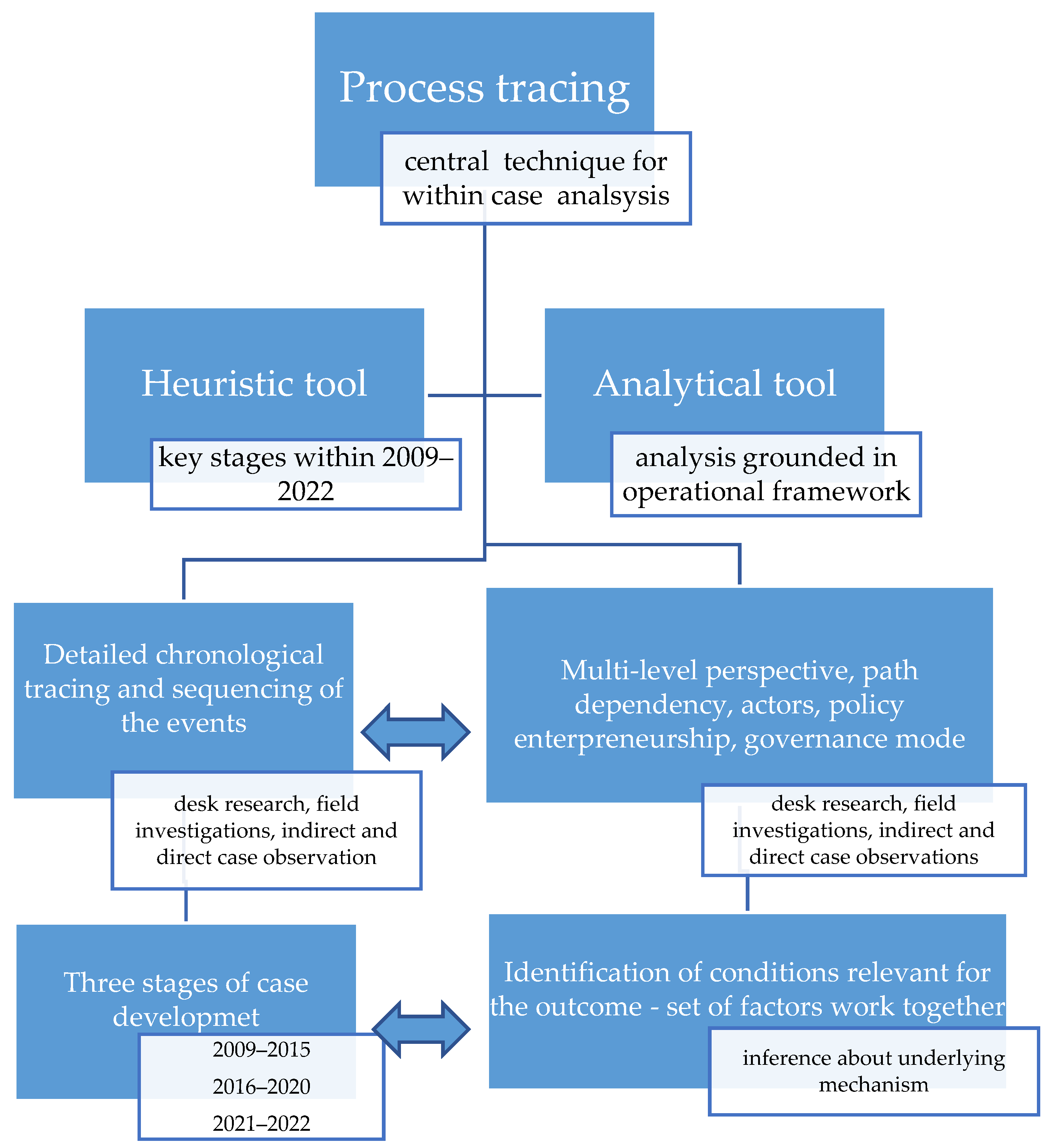
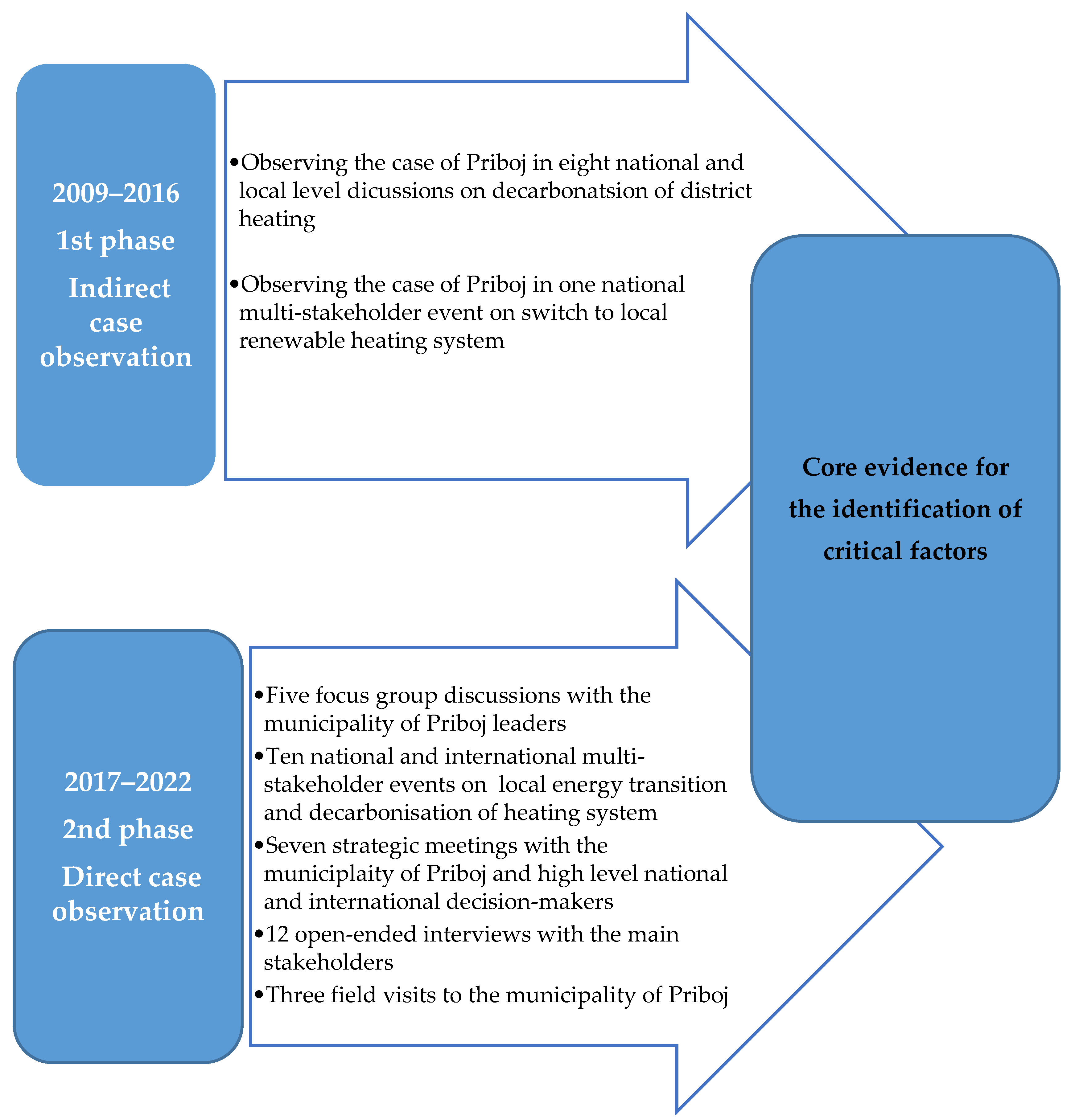

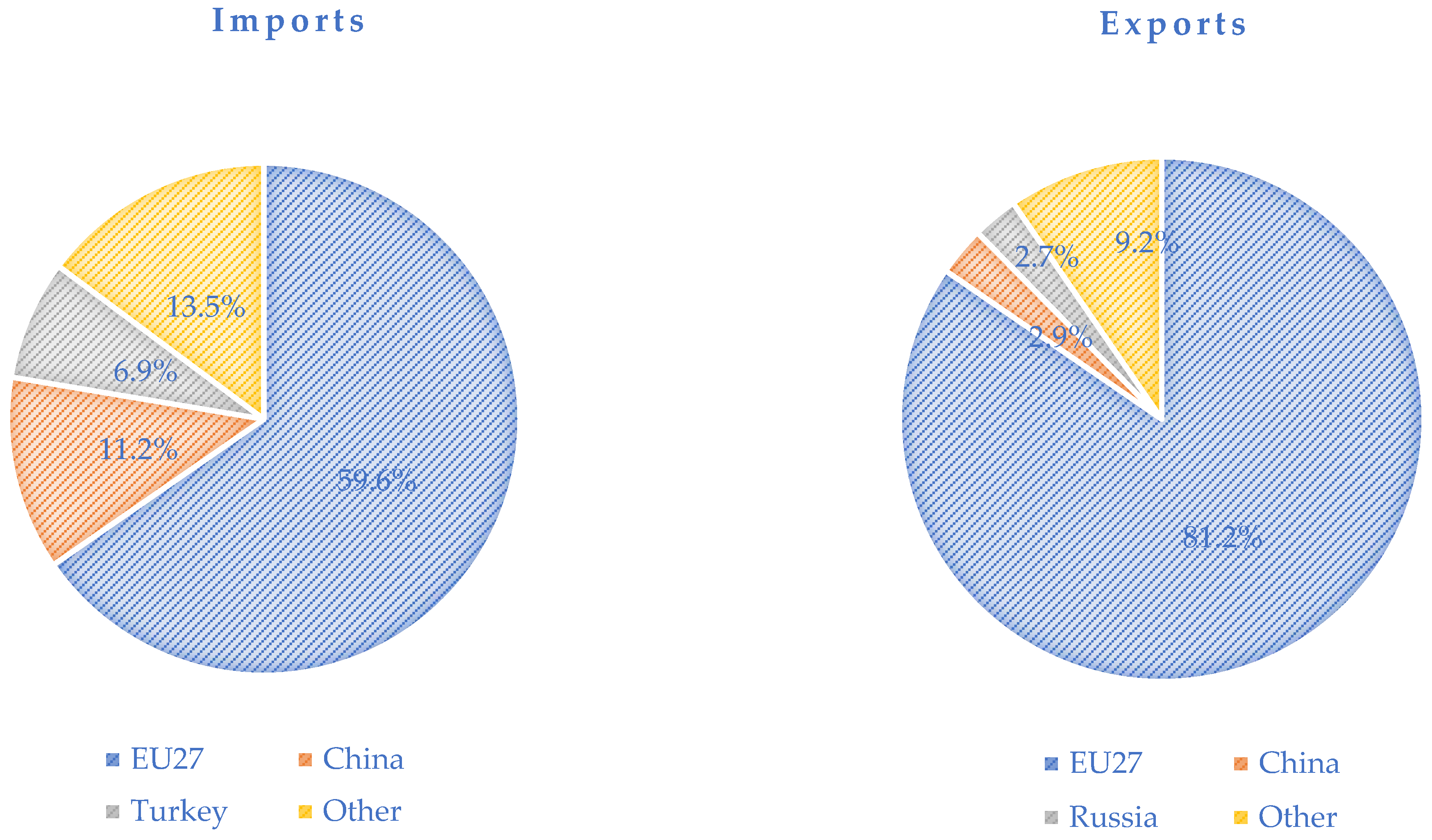
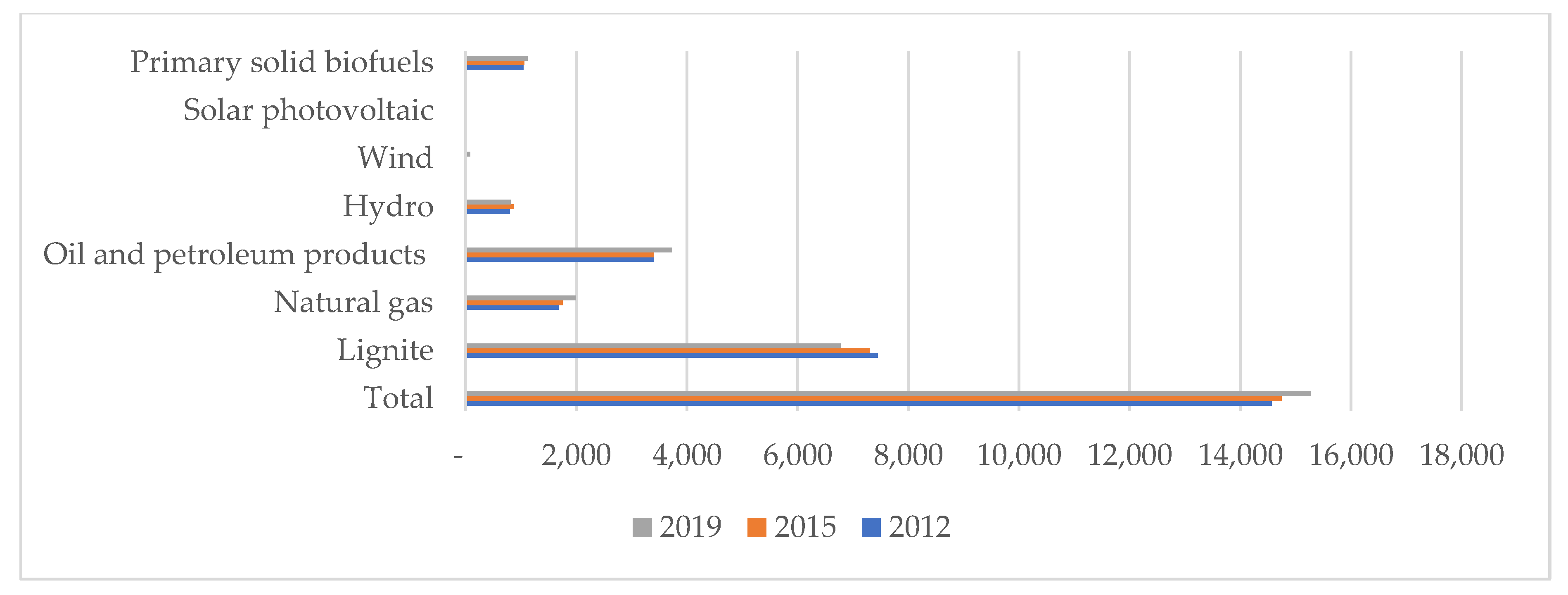
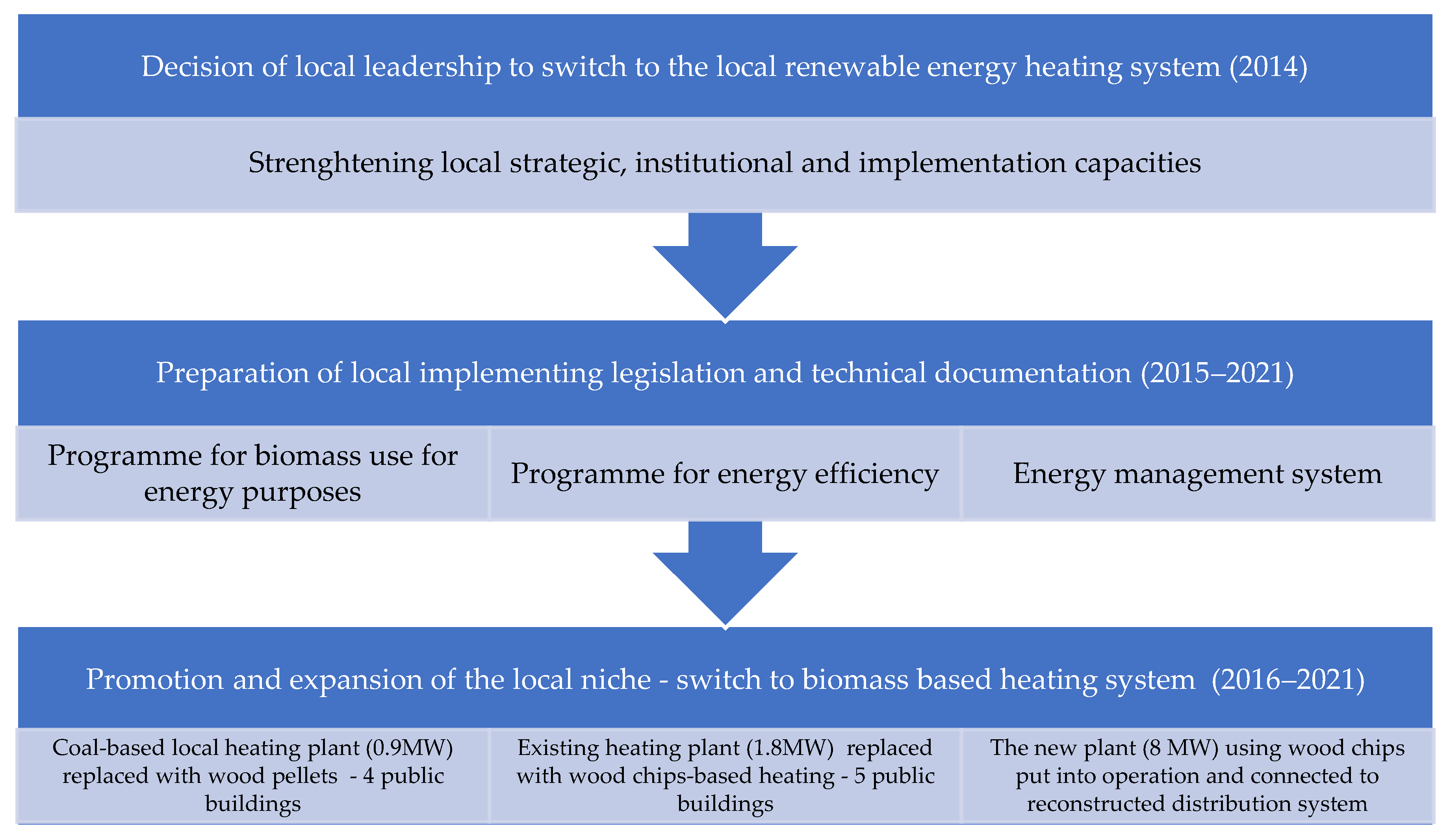

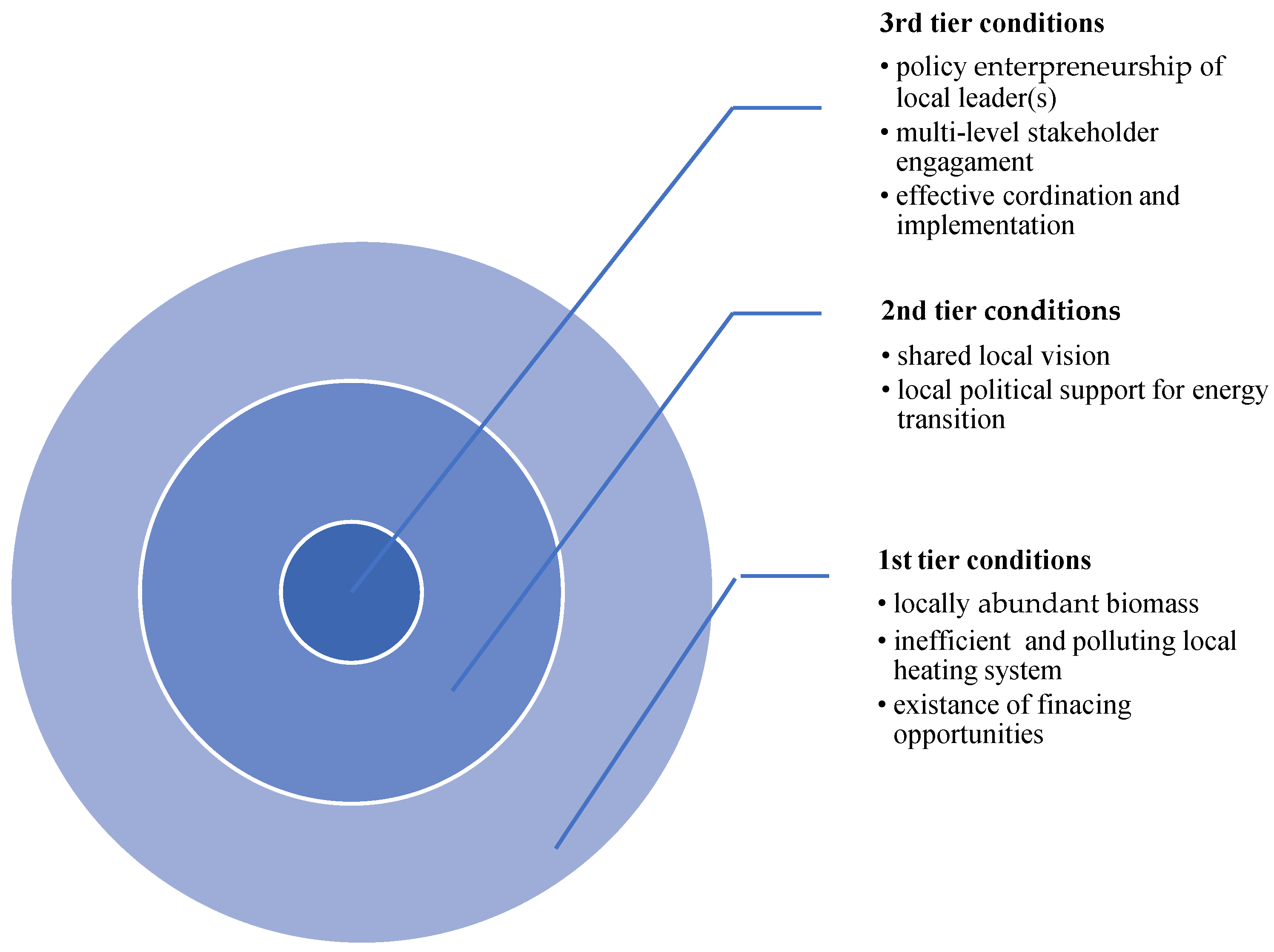
| Type of Renewable Energy Source | Target for 2020 (ktoe) | 2020 Energy Balance |
|---|---|---|
| Biomass—CHP plant heating | 49 | 0 |
| Biomass—CHP plant electricity | 55 | 0 |
| Biomass district heating | 25 | 2.17 |
| Biogas (manure)—CHP plant heating (energy transformation input from biogas for both heat and electricity) | 10 | 22 |
| Biogas (manure)—CHP plant electricity (energy transformation input from biogas for both heat and electricity) | 19 | 22 |
| Biomass in individual households (such data cannot be verified from the energy balance) | 50 | N/A |
Disclaimer/Publisher’s Note: The statements, opinions and data contained in all publications are solely those of the individual author(s) and contributor(s) and not of MDPI and/or the editor(s). MDPI and/or the editor(s) disclaim responsibility for any injury to people or property resulting from any ideas, methods, instructions or products referred to in the content. |
© 2023 by the authors. Licensee MDPI, Basel, Switzerland. This article is an open access article distributed under the terms and conditions of the Creative Commons Attribution (CC BY) license (https://creativecommons.org/licenses/by/4.0/).
Share and Cite
Young, J.; Macura, A. Forging Local Energy Transition in the Most Carbon-Intensive European Region of the Western Balkans. Energies 2023, 16, 2077. https://doi.org/10.3390/en16042077
Young J, Macura A. Forging Local Energy Transition in the Most Carbon-Intensive European Region of the Western Balkans. Energies. 2023; 16(4):2077. https://doi.org/10.3390/en16042077
Chicago/Turabian StyleYoung, Jasminka, and Aleksandar Macura. 2023. "Forging Local Energy Transition in the Most Carbon-Intensive European Region of the Western Balkans" Energies 16, no. 4: 2077. https://doi.org/10.3390/en16042077
APA StyleYoung, J., & Macura, A. (2023). Forging Local Energy Transition in the Most Carbon-Intensive European Region of the Western Balkans. Energies, 16(4), 2077. https://doi.org/10.3390/en16042077




